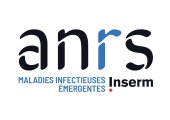Preventive vaccine against HIV: promising results in healthy volunteers with a new vaccine technology
 |
 |
 |
 |
Press release
Preventive vaccine against HIV: promising results in healthy
volunteers with a new vaccine technology
Paris, 2 October 2024
More than 40 years after the discovery of HIV, the development of a vaccine remains essential to control the epidemic. No candidate vaccine is currently being tested in phase III, all trials having been stopped due to lack of efficacy. The development of new vaccine candidates based on novel technologies is of interest. Scientists from the Vaccine Research Institute (VRI)* of Inserm and the Université Paris-Est Créteil (Unit 955 Mondor Institute for biomedical research), the CHUV in Lausanne and the University of Bordeaux are presenting the results of an innovative preventive HIV vaccine candidate in a study conducted in France and Switzerland. The phase I ANRS VRI06 trial, carried out by Inserm, ANRS MIE and VRI, shows that this vaccine, called CD40.HIVRI.Env, is safe and induces early and sustained humoral1 and cellular immune responses against HIV. This is the first study in humans with this vaccine, which consists of a monoclonal antibody2 fused to the HIV envelope, specifically targeting the CD40 molecule expressed at the surface of dendritic cells, cells involved in setting up protective immune responses. The results of this research have just been published in the October 2024 issue of eClinical Medicine (https://doi.org/10.1016/j.eclinm.2024.102845).
* The Vaccine Research Institute (or VRI) has been labelled “laboratory of excellence” by the French government and was established in 2011 by the ANRS Emerging infectious diseases (ANRS MIE) and the Université ParisEst Créteil (UPEC) to conduct research aimed at fostering the development of effective vaccines against
HIV/AIDS.
Developing an HIV vaccine remains a goal to eliminate or at least control the epidemic. The task remains difficult, and no vaccine is currently being tested in a phase III clinical trial. Challenges for vaccine development include the genetic diversity of the virus, its ability to escape from immune responses and the rapid establishment of viral reservoirs.
The vaccine candidate developed by VRI, called “CD40.HIVRI.Env”, is based on an innovative approach involving antigen-presenting cells (APCs)3 , in particular dendritic cells, which play an important role in the immune response. After detecting pathogens, dendritic cells present their antigens4 to the immune system and stimulate the specific response and generation of immune memory5.
Vaccination with CD40.HIVRI.Env, adjuvanted with Hiltonol® used to reinforce the potential action of the vaccine, is based on the injection of monoclonal antibodies that specifically target the CD40 molecule, a receptor on the surface of dendritic cells. These antibodies are fused to HIV envelope antigens (a laboratory-produced protein that is harmless because non-infectious), enabling direct antigen delivery to dendritic cells and generating a strong immune response. The immune system thus learns to recognise and neutralise the virus.
The immunogenicity (ability to induce an immune response) of the candidate vaccine, as well as its safety (absence of serious side effects), were evaluated for 48 weeks in 72 healthy volunteers in a phase I, placebo-controlled, dose-escalation study6 conducted in France and Switzerland. This is the first-in-human study of its kind with CD40.HIVRI.Env.
This adjuvanted candidate vaccine was administered alone (at doses of 0.3, 1 or 3 mg), or with the DNA-HIV-PT123 candidate vaccine (supplied by the EuroVacc Foundation), at D0 then 4 and 24 weeks after the first injection. This novel co-administration strategy was tested to see whether the immune response could be superior to that induced by the adjuvanted CD40.HIVRI.Env vaccine alone.
In terms of cellular immune response, envelope-specific CD47 T lymphocytes were detected in all vaccinated individuals at weeks (W) 6 and 26, i.e. after two or three injections, until W48, with no significant difference between dose levels. DNA-HIV-PT123 co-administration had no effect on the immune response, showing the high immunogenicity of adjuvanted CD40.HIVRI.Env.
In terms of humoral immune response (that which produces antibodies), CD40.HIVRI.Env induced high rates of antibodies directed against HIV envelope proteins, whatever the dose administered. Immunoglobulin G (IgG) response rates against gp140 and gp120 envelope glycoproteins of different HIV strains ranged from 89 to 100% after three injections. Antibodies targeting a specific area of the HIV envelope (the V1/V2 region) were also produced, regardless of the dose injected or co-administration. This type of response generated against gp120/gp140 and the V1/V2 region is reminiscent of that shown with antibodies targeting V1/V2 in a previous trial as a possible marker of protection against HIV infection.
Neutralising antibodies (specific antibodies that prevent infection by blocking entry of the virus into target cells) were also detected, with production describing a dose-response relationship.
The study demonstrated that the adjuvanted CD40.HIVRI.Env candidate vaccine was safe and well tolerated. No serious side effects were observed. General and local reactions at the injection site were mainly mild to moderate. Two severe adverse events were reported, which were found to be unrelated to vaccination after analysis.
Globally, the adjuvanted CD40.HIVRI.Env vaccine candidate is a safe vaccine that induces early, strong and sustained cellular and humoral immune responses. The results show that this type of vaccine specifically targeting the CD40 molecule expressed, in particular, by dendritic cells may be useful for inducing protective vaccine responses in prime-boost vaccination strategies8.
Notes
-
1. The one that produces antibodies.
-
2. Antibodies are proteins made by some cells of the immune system. Monoclonal antibodies are antibodies made in the
laboratory from a cell clone. Antibodies have the ability to recognise and specifically target certain cells. -
3. Immune system cells which “present” foreign molecules (antigens) to T lymphocytes, resulting in an immune response.
-
4. Foreign molecules found on invading pathogens and capable of triggering an immune response.
-
5. Capacity of an organism to remember an antigen with which it has already been in contact. Immune memory is attributed tolymphocytes.
-
6. Dose-escalation studies aim to determine the maximum tolerated dose, i.e. the dose beyond which adverse effects are no
longer tolerable. -
7. White blood cells involved in the body’s immune defence against infectious attacks.
-
8. Prime-boost strategy is a multi-stage vaccination strategy.
Reference: Levy Y1,2,3, Moog C3,4*, Wiedemann A1,3*, Launay O5,6, Candotti F7, Hardel L3,8, Durand M3,8, Rieux V9, Diallo A9, Lacabaratz C1,3, Cardinaud S1,3, Zurawski S3,10, Zurawski G3,10, Tomaras GD11, Ding S12, Centlivre M1,3, Thiebaut R3,13,14,15, Pantaleo G7, Lelièvre J-D1,2,3#, Richert L3,13,14,15#, and the ANRS VRI06 Study Group.
Safety and immunogenicity of CD40.HIVRI.Env, a dendritic cell-based HIV vaccine, in healthy HIV-uninfected adults: a first-in-human randomized, placebo-controlled, dose escalation study (ANRS VRI06). eClinical Medicine (https://doi.org/10.1016/j.eclinm.2024.102845).
1. INSERM U955, IMRB, Univ. Paris Est Créteil, Créteil, France
2. Groupe Henri-Mondor Albert-Chenevier, AP-HP, Créteil, France
3. Vaccine Research Institute, France
4. INSERM UMR_S1109, University of Strasbourg, Strasbourg, France
5. CIC 1417 F-CRIN I-REIVAC, INSERM, Hôpital Cochin, AP-HP, Paris, France
6. Université Paris Descartes, Paris France
7. Centre Hospitalier Universitaire Vaudois, Lausanne, Switzerland
8. Univ. Bordeaux, INSERM, MART, UMS 54, Bordeaux, France
9. ANRS MIE, Paris, France
10. Baylor Scott & White Research Institute, Dallas, Texas
11. Duke University School of Medicine, Durham, North Carolina
12. EuroVacc Foundation, Lausanne, Switzerland
13. Univ. Bordeaux, INSERM, Bordeaux Population Health Research Center, UMR1219, Bordeaux, France
14. Inria SISTM team, Talence, France
15. Bordeaux University Hospital, Medical Information Department, Bordeaux, France
* and #: contributed equally.
About ANRS MIE: ANRS Emerging Infectious Diseases is an autonomous agency of Inserm (the French National Institute for Health and Medical Research). Its mission is to facilitate, evaluate, coordinate and fund research into HIV/AIDS, viral hepatitis, sexually transmitted infections, tuberculosis and emerging and re-emerging infectious diseases.
For more information: https://anrs.fr/en/
About the VRI and Inserm: The Vaccine Research Institute (VRI), Laboratory of excellence, was established by Inserm (French National Institute of Health and Medical Research) and the University of Paris-Est Créteil (UPEC) to conduct research to accelerate the development of effective vaccines against HIV/AIDS and (re)-emerging infectious diseases. The VRI’s structure strengthens the links between basic research and translational research, patients associations and the socio-economic world. The VRI extends a network of internationally renowned scientists and research teams with multidisciplinary expertise in system biology and clinical immunology, a network of clinical centres, shared platform.
For more information: https://vaccine-research-institute.fr/
Founded in 1964, Inserm is a public scientific and technological institute dedicated to biomedical research and human health, and is involved in the entire range of activities from the laboratory to the patient’s bedside. It also partners with the most prestigious research institutions in the world that are committed to scientific challenges and progress in these fields.
For more information: https://www.inserm.fr/en/home/
About université Paris-Est Créteil: With 14 faculties, schools and institutes, 1 observatory and 32 research laboratories, Université Paris-Est Créteil has been active in all fields of knowledge since 1970. Each year, UPEC trains over 42,000 students and working professionals of all ages.
A major player in the dissemination of academic, scientific and technological knowledge, the university offers more than 500 training courses in all disciplines and at all levels. UPEC offers personalized support for all successes, thanks to undergraduate and graduate training, recognition of prior learning and lifelong learning opportunities. Furthermore, the university runs a growing number of apprenticeship programs in order to stimulate entrepreneurship and ease professional integration.
Université Paris-Est Créteil has built its strategic plan around three strategic orientations: UPEC is an engaged university that aims to match academic excellence with societal relevance. It encourages and supports all paths of students’ success with dedicated programs. UPEC masters its trajectory and is a university open to the world and its diversity
For more information: https://www.en.u-pec.fr/
About the University of Bordeaux: With more 54,000 students, 3,200 researchers and teachers, and 2,800 staff members, the University of Bordeaux is one of the leading French public research and higher education institutions, located in a dynamic and culturally rich, fast-developing region.
Ranked among the top universities in France, the University of Bordeaux is renowned for the quality of its academic courses and research. It is a multi-disciplinary, research-focused institution with a strong ambition to develop as a leading, international campus. The University of Bordeaux is leading an ambitious, competitive development program in partnership with local higher education institutes and national research organizations, in order to promote Bordeaux as a “Campus of Excellence”..
For more information: https://www.u-bordeaux.fr/en
Press contact: ANRS MIE
presse@anrs.fr